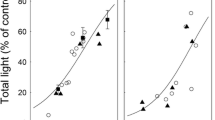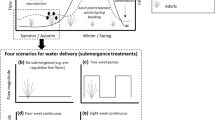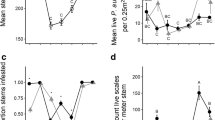Abstract
Docks constructed over salt marsh can reduce vegetation production and associated ecosystem services. In Massachusetts, there is a 1:1 height-to-width ratio (H:W) dock design guideline to reduce such impacts, but this guideline’s efficacy is largely untested. To evaluate dock height effects on underlying marsh vegetation and light availability, we deployed 1.2-m-wide experimental docks set at three different heights (low (0.5:1 H:W), intermediate (1:1 H:W), and high (1.5:1 H:W)) in the high and low marsh zones in an estuary in Massachusetts, USA. We measured temperature, light, vegetation community composition, and stem characteristics under the docks and in unshaded control plots over three consecutive growing seasons. Temperature and light were lower under all docks compared with controls; both increased with dock height. Maximum stem height and nitrogen content decreased with available light. In the Spartina patens-dominated high marsh, stem density and biomass were significantly lower than controls under low and intermediate but not high docks. Spartina alterniflora, the dominant low marsh vegetation, expanded into the high marsh zone under docks. S. alterniflora aboveground biomass significantly differed among all treatments in the low marsh, while stem density was significantly reduced for low and intermediate docks relative to controls. Permit conditions and guidelines based on dock height can reduce dock impacts, but under the current guideline of 1:1 H:W, docks will still cause significant adverse impacts to vegetation. Such impacts may interfere with self-maintenance processes (by decreasing sediment capture) and make these marshes less resilient to other stressors (e.g., climate change).









Similar content being viewed by others
Change history
03 October 2018
In the original article there was an error in the reported quadrat size. Sample quadrats were described as 1/16 m2 when they should have been reported as 1/32 m2 in the text of page 16 and in the figure legend for Figs. 6 and 7.
References
Alexander, C. 2012. Field assessment and simulation of shading from alternative dock construction materials. Final Report 18 March 2012. http://www.skio.uga.edu/research/geo/sedimentology/downloads/FACM.pdf. Accessed 5 Jan 2017.
Alexander, C., and M. Robinson. 2004. GIS and field-based analysis of the impacts of recreational docks on the saltmarshes of Georgia. Skidaway Institute of Oceanography Technical Report. 40 pp. http://www.skio.uga.edu/research/geo/sedimentology/downloads/dock_impact.pdf. Accessed 5 Jan 2017.
Alexander, C., and M. Robinson. 2006. Quantifying the ecological significance of marsh shading: the impact of private recreational docks in coastal Georgia. Submitted to Coastal Resources Division Georgia Department of Natural Resources Brunswick, GA. https://www.researchgate.net/publication/228713759_QUANTIFYING_THE_ECOLOGICAL_SIGNIFICANCE_OF_MARSH_SHADING_THE_IMPACT_OF_PRIVATE_RECREATIONAL_DOCKS_IN_COASTAL_GEORGIA. Accessed 5 Jan 2017.
Baker, H.K., J.A. Nelson, and H.M. Leslie. 2016. Quantifying striped bass (Morone saxatilis) dependence on saltmarsh-derived productivity using stable isotope analysis. Estuaries and Coasts 39: 1537–1542.
Banning, A.E., J.L. Bowman, and B.L. Vasilas. 2009. Effects of long piers on birds in tidal wetlands. The Journal of Wildlife Management 73: 1362–1367.
Barbier, E.B., S.D. Hacker, C. Kennedy, E.W. Koch, A.C. Stier, and B.R. Silliman. 2011. The value of estuarine and coastal ecosystem services. Ecological Monographs 81: 169–193.
Bertness, M.D. 1991. Zonation of Spartina patens and Spartina alterniflora in New England salt marsh. Ecology 72: 138–148.
Bertness, M.D., and A.M. Ellison. 1987. Determinants of pattern in a New England salt marsh plant community. Ecological Monographs 57: 129–147.
Bertness, M.D., and S.D. Hacker. 1994. Physical stress and positive associations among marsh plants. The American Naturalist 144: 363–372.
Bliven, S., and S. Pearlman. 2003. A guide to permitting small pile-supported docks and piers. Massachusetts Department of Environmental Protection, Bureau of Resource Protection, Wetlands/Waterways Program. 28 pp. http://www.mass.gov/eea/docs/dep/water/resources/n-thru-y/smaldock.pdf. Accessed 5 Jan 2017.
Boesch, D.F., and R.E. Turner. 1984. Dependence of fishery species on salt marshes: the role of food and refuge. Estuaries 7: 460–468.
Buchsbaum, R. 2001. Coastal marsh management. In Applied wetlands science and technology, second addition, ed. D.M. Kent, 323–350. Boca Raton: Lewis Publishers.
Burdick, D.M., and F.T. Short. 1999. The effects of boat docks on eelgrass beds in coastal waters of Massachusetts. Environmental Management 23: 231–240.
Castillo, J.M., A.E. Rubio-Casal, and E. Figueroa. 2010. Cordgrass biomass in coastal marshes. In Biomass, ed. M. Momba and F. Bux, 183–202. Croatia: Sciyo.
Chaisson, C. 2012. Factors influencing stem density of creekbank Spartina alterniflora in a New England salt marsh. Botany Honors Papers, Paper 3. Connecticut College, New London, CT, USA http://digitalcommons.conncoll.edu/botanyhp/3. Accessed 5 Jan 2017.
Chinnis, R., and L.W. Stidham. 2001. Dock and pier management, the South Carolina experience. Proceedings of the 12th Biennial Coastal Zone Conference. Cleveland, OH, July 15–19, 2001.
Colligan, M., and C. Collins. 1995. The effect of open-pile structures on salt marsh vegetation. NOAA/NMFS Pre-publication Draft Report.
COMAR. 2016. COMAR. Maryland Code of Regulations: 26.24.04.02 piers and boathouses. http://www.dsd.state.md.us/comar/comarhtml/26/26.24.04.02.htm. Accessed 19 Sept 2016.
Connecticut Department of Energy & Environmental Protection. 2015. Residential dock guidelines. http://www.ct.gov/deep/cwp/view.asp?a=2705&q=323798. Accessed 16 Nov 2016.
Deegan, L.A., and R.H. Garritt. 1997. Evidence for spatial variability in estuarine food webs. Marine Ecology Progress Series 147: 31–47.
Deegan, L.A., J.E. Hughes, and R.A. Rountree. 2000. Salt marsh ecosystem support of marine transient species. In Concepts and controversies in tidal marsh ecology, ed. M.P. Weinstein and D.A. Kreeger, 333–365. The Netherlands: Kluwer Academic Publisher.
Deegan, L.A., D.S. Johnson, R.S. Warren, B.J. Peterson, J.W. Fleeger, S. Fagherazzi, and W.M. Wollheim. 2012. Coastal eutrophication as a driver of salt marsh loss. Nature 490: 388–392.
Duarte, B., J.C. Marques, and I. Caçador. 2016. Ecophysiological response of native and invasive Spartina species to extreme temperature events in Mediterranean marshes. Biological Invasions 18: 2189–2205.
Gedan, K.B., and M.D. Bertness. 2009. Experimental warming causes rapid loss of plant diversity in New England salt marshes. Ecology Letters 12: 842–848.
Gedan, K.B., and M.D. Bertness. 2010. How will warming affect the salt marsh foundation species Spartina patens and its ecological role? Oecologia 164: 479–487.
Gissy, M. 1985. Europe’s salt marshes: urgent need for protective network of reserves. Environmental Conservation 12: 371–372.
Gleason, M.L., D.A. Elmer, N.C. Pien, and J.S. Fisher. 1979. Effects of stem density upon sediment retention by salt marsh cord grass, Spartina alterniflora loisel. Estuaries 2: 271–273.
Gleason, M.L., and J.C. Zieman. 1981. Influence of tidal inundation on internal oxygen supply of Spartina alterniflora and Spartina patens. Estuarine, Coastal and Shelf Science 13: 47–57.
Grice, A.M., N.R. Loneragan, and W.C. Dennison. 1996. Light intensity and the interactions between physiology, morphology and stable isotope ratios in five species of seagrass. Journal of Experimental Marine Biology and Ecology 195: 91–110.
Havens, K.J., L.M. Varnell, and J.G. Bradshaw. 1995. An assessment of ecological conditions in a constructed tidal marsh and two natural reference tidal marshes in coastal Virginia. Ecological Engineering 4: 117–141.
Holm, S. 1979. A simple sequentially rejective multiple test procedure. Scandinavian Journal of Statistics 6: 65–70.
Kearney, V.F., Y. Segal, and M.W. Lefor. 1983. The effects of docks on salt marsh vegetation. Hartford: Connecticut State Department of Environmental Protection 22 pp.
Kelty, R., and S. Bliven. 2003. Environmental and aesthetic impacts of small docks and piers. Workshop report: developing a science-based decision support tool for small dock management, phase 1: status of the science. NOAA Coastal Ocean Program Decision Analysis Series No. 22. National Centers for Coastal Ocean Science, Silver Spring, MD. 69 pp. https://www.coastalscience.noaa.gov/documents/dockpier.pdf. Accessed 5 Jan 2017.
Kennish, M.J. 2001. Coastal salt marsh systems in the U.S.: a review of anthropogenic impacts. Journal of Coastal Research 17: 731–748.
Kennish, M.J. 2002. Environmental threats and environmental future of estuaries. Environmental Conservation 29: 78–107.
Kennish, M.J. 2016. Anthropogenic impacts. In Encyclopedia of estuaries, ed. M.J. Kennish, 29–35. Berlin: Springer.
LeMay, L.E. 2007. The impact of drainage ditches on salt marsh flow patterns, sedimentation and morphology: Rowley River, Massachusetts. Master’s Thesis. The College of William and Mary in Virginia. http://web.vims.edu/library/theses/LeMay07.pdf?svr=www. Accessed 5 Jan 2017.
Logan, J., Davis, A., and K. Ford. 2015. Environmental impacts of docks and piers on salt marsh vegetation across Massachusetts estuaries - a quantitative field survey approach. Final Report Submitted to the Massachusetts Bays Program. http://www.mass.gov/eea/docs/mbp/publications/dmf-dock-shading-study-2014.pdf. Accessed 5 Jan 2017.
Long, M.H., J.E. Rheuban, P. Berg, and J.C. Zieman. 2012. A comparison and correction of light intensity loggers to photosynthetically active radiation sensors. Limnology and Oceanography: Methods 10: 416–424.
MacDonnell, C.A. 2014. Wildlife lands: administration, acquisition & stewardship. In Massachusetts Division of Fisheries & Wildlife 2014 Annual Report. http://www.mass.gov/eea/agencies/dfg/dfw/publications/2014-dfw-anrep-final.pdf. Accessed 30 Dec 2016.
Mansfield, A., and S. Grady. 2015. Jones, North, and South Rivers salt marsh assessment. Final Report Submitted to Massachusetts Bays Program January 29, 2015. http://jonesriver.org/getfile/saltmarsh/JonesNorthSouthRivers_SaltMarshAssessment_FinalTechReport.pdf. Accessed 30 Dec 2016.
Mcleod, E., G.L. Chmura, S. Bouillon, R. Salm, M. Bjӧrk, C.M. Duarte, C.E. Lovelock, W.H. Schlesinger, and B.R. Silliman. 2011. A blueprint for blue carbon: toward an improved understanding of the role of vegetated coastal habitats in sequestering CO2. Frontiers in Ecology and the Environment 9: 552–560.
Medeiros, D.L., D.S. White, and B.L. Howes. 2013. Replacement of Phragmites australis by Spartina alterniflora: the role of competition and salinity. Wetlands 33: 421–430.
Moore, K.A., and R.L. Wetzel. 2000. Seasonal variations in eelgrass (Zostera marina L.) responses to nutrient enrichment and reducted light availability in experimental ecosystems. Journal of Experimental Marine Biology and Ecology 244: 1–28.
Morris, J.T., P.V. Sundareshwar, C.T. Nietch, B. Kjerfve, and D.R. Cahoon. 2002. Responses of coastal wetlands to rising sea level. Ecology 83: 2869–2877.
Needles, L.A., S.E. Lester, R. Ambrose, A. Andren, M. Beyeler, M.S. Connor, J.E. Eckman, B.A. Costa-Pierce, S.D. Gaines, K.D. Lafferty, H.S. Lenihan, J. Parrish, M.S. Peterson, A.E. Scaroni, J.S. Weis, and D.E. Wendt. 2015. Managing bay and estuarine ecosystems for multiple services. Estuaries and Coasts 38: 35–48.
New Hampshire Department of Environmental Services. 2009. Environmental fact sheet. Permitting of tidal docks. http://des.nh.gov/organization/commissioner/pip/factsheets/wet/documents/wb-15.pdf. Accessed 15 Nov 2016.
Patterson, M.M. 2003a. Residential docks and piers: inventory of laws, regulations, and policies for the southeastern United States. http://aquaticcommons.org/2223/1/Southeastern_Dock_Pier_Inventory.pdf. Accessed 5 Jan 2017.
Patterson, M.M. 2003b. Residential docks and piers: inventory of laws, regulations, and policies for the New England region. http://aquaticcommons.org/2222/1/New_England_Dock_Pier_Inventory.pdf. Accessed 5 Jan 2017.
Peralta, G., J.L. Pérez-Lloréns, I. Hernández, and J.J. Vergara. 2002. Effects of light availability on growth, architecture and nutrient content of the seagrass Zostera noltii Hornem. Journal of Experimental Marine Biology and Ecology 269: 9–26.
R Core Team. 2016. R: A language and environment for statistical computing. Vienna: R Foundation for Statistical Computing URL http://www.R-project.org/.
Roman, C.T., James-Pirri, M.J., and J.F. Heltshe. 2001. Monitoring salt marsh vegetation - a protocol for the Long-term Coastal Ecosystem Monitoring Program at Cape Cod National Seashore. https://www.nps.gov/caco/learn/nature/upload/hydro_protocol_form.pdf. Accessed 5 Jan 2017.
Sanger, D.M., and A.F. Holland. 2002. Evaluation of the impacts of dock stuctures on South Carolina estuarine environments. Final report Submitted to: Office of Ocean and Coastal Resource Management South Carolina Department of Health and Environmental Control 1362 McMillan Avenue, Suite 400 Charleston, SC 29405. http://mrl.cofc.edu/pdf/techreport99.pdf. Accessed 5 Jan 2017.
Sanger, D.M., A.F. Holland, and C. Gainey. 2004. Cumulative impacts of dock shading on Spartina alterniflora in South Carolina estuaries. Environmental Management 33: 741–748.
Seabrook, C. 2012. The world of the salt marsh: Appreciating and protecting the tidal marshes of the southeastern Atlantic coast. Athens: The University of Georgia Press.
Smith, J.P., and M. Carullo. 2007. Survey of potential marsh dieback sites in coastal Massachusetts. Massachusetts Bays National Estuary Program and Massachusetts Office of Coastal Zone Management. http://www.mass.gov/eea/docs/czm/habitat/marsh-dieback-report.pdf. Accessed 30 Dec 2016.
Struck, S.D., C.B. Craft, S.W. Broome, M.D. Sanclements, and J.N. Sacco. 2004. Effects of bridge shading on estuarine marsh benthic invertebrate community structure and function. Environmental Management 34: 99–111.
The New England District US Army Corps of Engineers. 2012. Department of the army programmatic general permit for the state of New Hampshire. http://www.nae.usace.army.mil/Portals/74/docs/regulatory/StateGeneralPermits/NHPGPAug2013.pdf. Accessed 6 April 2017.
The New England District US Army Corps of Engineers. 2015. Department of the army general permit for the state of Maine. http://www.nae.usace.army.mil/Portals/74/docs/regulatory/StateGeneralPermits/ME/Maine_General_Permit_2015.pdf. Accessed 6 April 2017.
The Savannah District US Army Corps of Engineers. 2012. Joint public notice revision and reissuance of programmatic general permit 0083 for private single-family docks in Bryan, Brantley, Camden, Charlton, Chatham, Effingham, Glynn, Liberty, Long, McIntosh and Wayne Counties, Georgia. http://www.coastalgadnr.org/sites/uploads/crd/pdf/permitapps2011/PGPapp.pdf. Accessed 5 Jan 2017.
van Lent, F., J.M. Verschuure, and M.L.J. van Veghel. 1995. Comparative study on populations of Zostera marina L. (eelgrass): in situ nitrogen enrichment and light manipulation. Journal of Experimental Marine Biology and Ecology 185: 55–76.
Vasilas, B.L., J. Bowman, A. Rogerson, A. Chirnside, and W. Ritter. 2011. Environmental impact of long piers on tidal marshes in Maryland—vegetation, soil, and marsh surface effects. Wetlands 39: 423–431.
Weis, J.S., and P. Weis. 1992a. Construction materials in estuaries: reduction in the epibiotic community on chromated copper arsenate (CCA) treated wood. Marine Ecology Progress Series 83: 45–53.
Weis, J.S., and P. Weis. 1992b. Transfer of contaminants from CCA-treated lumber to aquatic biota. Journal of Experimental Marine Biology and Ecology 161: 189–199.
Weis, J.S., P. Weis, and T. Proctor. 1998. The extent of benthic impacts of CCA-treated wood structures in Atlantic coast estuaries. Archives of Environmental Contamination and Toxicology 34: 313–322.
Weis, P., J.S. Weis, and E. Lores. 1993. Uptake of metals from chromated-copper-arsenate (CCA)-treated lumber by epibiota. Marine Pollution Bulletin 26: 428–430.
Acknowledgments
Charles Markos, Sara Grady, Emily Pitman, and Margo Lee provided assistance with field sampling. Mark Altabet provided laboratory space, and Jessica Drysdale assisted with elemental analysis. Vincent Manfredi provided equipment for electronic stem measurements. Linda Deegan, Robert Boeri, Jay Wennemer, and Maureen Thomas provided constructive feedback on the initial design of this study. David Burdick and an anonymous reviewer provided helpful comments on earlier drafts of this manuscript. We would like to thank the residents of Trouant’s Island, especially James Tarbox, for being accommodating neighbors to our field site. This work was funded by a grant from the Massachusetts Bays National Estuary Program (MassBays).
Author information
Authors and Affiliations
Corresponding author
Additional information
Communicated by Nathan Waltham
Electronic Supplementary Material
Online Resource 1
(DOCX 27 kb)
Online Resource 2
(DOCX 26 kb)
Online Resource 3
(DOCX 27 kb)
Online Resource 4
(DOCX 28 kb)
Online Resource 5
(DOCX 31 kb)
Online Resource 6
(DOCX 29 kb)
Online Resource 7
(DOCX 13 kb)
Rights and permissions
About this article
Cite this article
Logan, J.M., Voss, S., Davis, A. et al. An Experimental Evaluation of Dock Shading Impacts on Salt Marsh Vegetation in a New England Estuary. Estuaries and Coasts 41, 13–24 (2018). https://doi.org/10.1007/s12237-017-0268-4
Received:
Revised:
Accepted:
Published:
Issue Date:
DOI: https://doi.org/10.1007/s12237-017-0268-4




